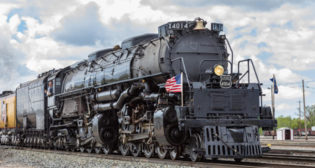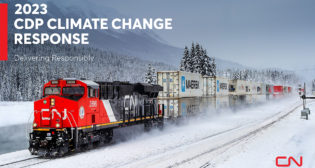
Follow the Megawatt-Hours: Hydrogen Fuel Cells, Batteries and Electric Propulsion
Written by Michael Iden, P.E., Contributing Editor and Consultant, Tier 5 Locomotive LLC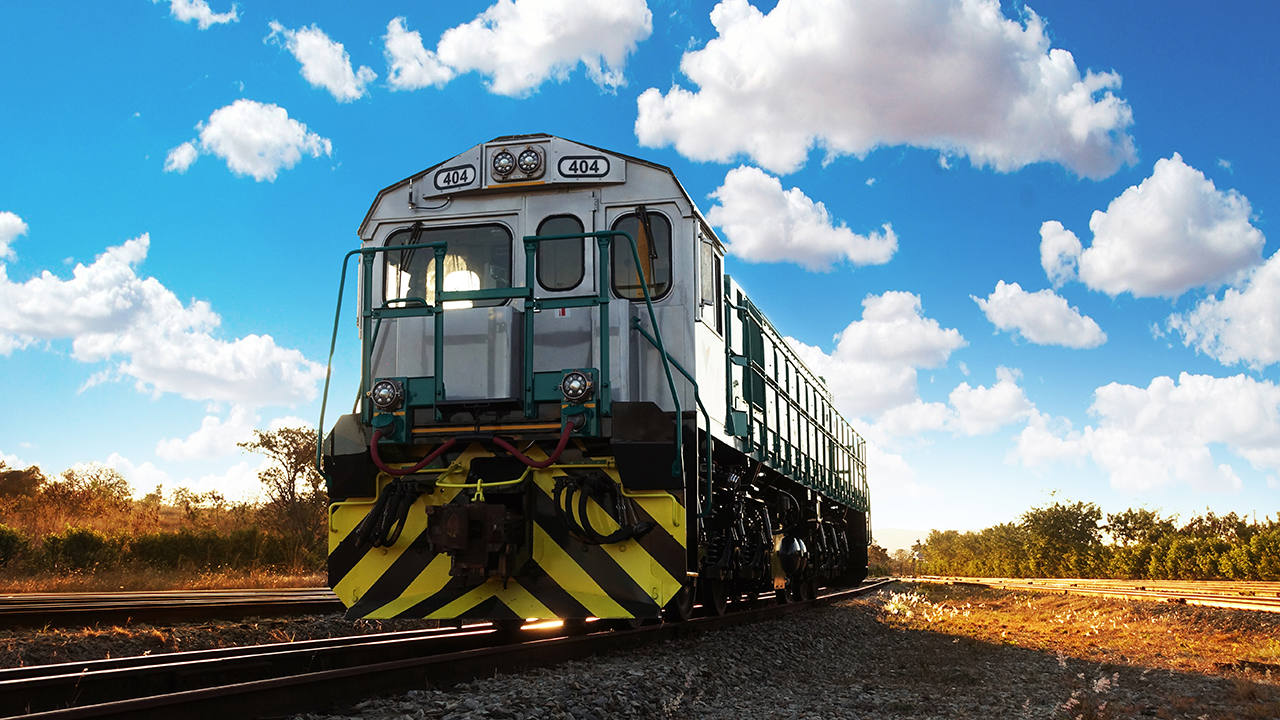
Progress Rail EMD® GT38JC Joule. Progress Rail photo
RAILWAY AGE, MARCH 2023 ISSUE: A discussion of propulsion options for freight rail is offered by seasoned locomotive mechanical engineer Michael Iden, a former mechanical department officer with Union Pacific, offering insight from his years of practical experience with new technologies and research and development.
As the railroad industry moves toward decarbonized propulsion, it’s critical that we start looking analytically at each technology and supporting infrastructure, and begin developing the comparative economics. We’re talking, in this article, about hydrogen fuel cells and propulsion batteries (plus one very mature technology that continues to be “written off,” and a unique variant).
Managing technology is never easy, and new technologies always introduce a sometimes unclear mix of benefits and risks. Borrowing an adage from carpentry: “measure (at least) twice and cut only once.”
Our industry has been dieselized for 63 years (Class I steam died May 7, 1960), having evolved from the steam-to-diesel transition (1940-1960) plus a previous decade-plus of research, trial and error. Coal as locomotive fuel was often 10% of all carloads. The infrastructure was massive and labor-intensive. A single steam locomotive could consume 90,000 gallons of water between New York City and Chicago. The transition to diesel was a classic example of disruptive industrial innovation with positive and negative impacts on railroads, employees, stockholders, suppliers and communities.
Railroads did become more productive; today, they produce 63% more work (gross ton-miles, GTMs) annually using only 1/9th the equivalent energy as they did in 1945, steam’s peak.
Upfront disclosure: As a trained professional engineer, I believe there will be valid applications for both hydrogen fuel-cell and battery-electric locomotives, but neither is a “one size fits all ‘silver bullet’ solution.” Also, I’m not giving up on diesel engines, as they could be hybridized by adding propulsion batteries (a separate discussion for another time).
This is very clear: Decarbonized grid electricity will increasingly be our primary energy source. Clean renewable electricity (some call it a trillion-dollar national investment) will manufacture hydrogen and recharge batteries. But it can also power electrification of selective heavy-density routes. We cannot dismiss any option without a factual assessment. The business cases for hydrogen and batteries should be prepared and compared to the case for electrification (along with a business case for a unique variant offering faster cash payback).
Another reality: The “pull any train on any railroad” diesel locomotive will gradually be supplanted or possibly replaced, by new technologies. New-technology locomotives may not be common or interchangeable when introduced, and completing rail decarbonization will likely take 15-20 years (the 2050 target for net-zero carbon is only 26 years away!). Fuel cell and battery-electric locomotives will be “corridor and infrastructure limited” until thousands of such new units are in service, drawing attention again to infrastructure requirements and comparative energy efficiencies.
SELECTING PROPULSION TECHNOLOGIES: HOW MUCH TONNAGE MOVES WHERE?
Railroads should, in a serious and unbiased way, re-examine electrification of the heaviest-density trackage (7% to 10% of the 140,000 U.S. route-miles that handle about 30% of all GTMs). I’m not suggesting a “Switzerland approach” stringing catenary over all tracks (even in yards). The amount of transportation work (GTMs) drives the energy needed (energy is “the capacity to do work”).
Electrifying the smallest part of our network carrying the greatest tonnage will have a positive and amplified effect on our competitive energy efficiency. The remaining network can be powered with hydrogen fuel cells and/or batteries (or enhanced diesel locomotives), with each technology achieving an optimum solution.
WHERE DO WE GET HYDROGEN?
Hydrogen must be manufactured, preferably using “clean renewable” (zero-carbon) electricity to power a process called electrolysis. An “electrolyzer” uses electricity to disassociate or break apart water molecules (H2O) into H2 and O2, and then we need even more electrical energy to compress or liquefy (“cryogenically refrigerate”) the H2 to make a practical and transportable “energy carrier” for locomotives or H2 fuel tenders. Chemically, 2.4 U.S. gallons of deionized (not ordinary “tap”) water can be converted into 1 kilogram (kg, roughly 2.2 pounds) of hydrogen with an energy content roughly the same as 1 U.S. gallon of diesel fuel. But electrolysis also needs significant amounts of water for process cooling, as much as 15-to-25 U.S. gallons of water per kilogram of hydrogen. Plus (critical in comparing hydrogen fuel cells to selective electrification) about 1.5 megawatt-hours of “input” electrical energy is needed to produce 1 megawatt-hour of energy stored in hydrogen. The 67% grid-to-hydrogen energy efficiency is the inevitable result of “process inefficiencies” (33% of the input energy is “lost”).
Looking at a fuel cell-for-diesel replacement scenario, in 2019 BNSF reported pumping up to 300 million gallons of diesel fuel annually at Belen, N.Mex. (population 7,423). Assuming all diesels through Belen were replaced with fuel cell locomotives, the 300 million gallons of diesel would be replaced by 300 million kg of hydrogen. Making that much hydrogen will require 12-to-20 million gallons of water every day (4.4 billion to 7.3 billion gallons every year), equal to 18% of neighboring Albuquerque’s water demand for 563,000 people. Recall that the Santa Fe Railway first dieselized across Arizona and New Mexico 1940-1942 to overcome the lack of “good” boiler water. And the southwestern U.S. is now in a monumental drought. Will there be enough water and renewable electricity? “Maybe” is not a sufficient answer for a major project.
Can hydrogen be a hybrid fuel? Yes, perhaps as a “dual fuel” alongside diesel in modified diesel engines, instead of being consumed by fuel cells, but not necessarily in all diesel engines.
GRID TO RAIL ENERGY EFFICIENCY: MEGAWATT-HOURS “IN”, GTMs “OUT”
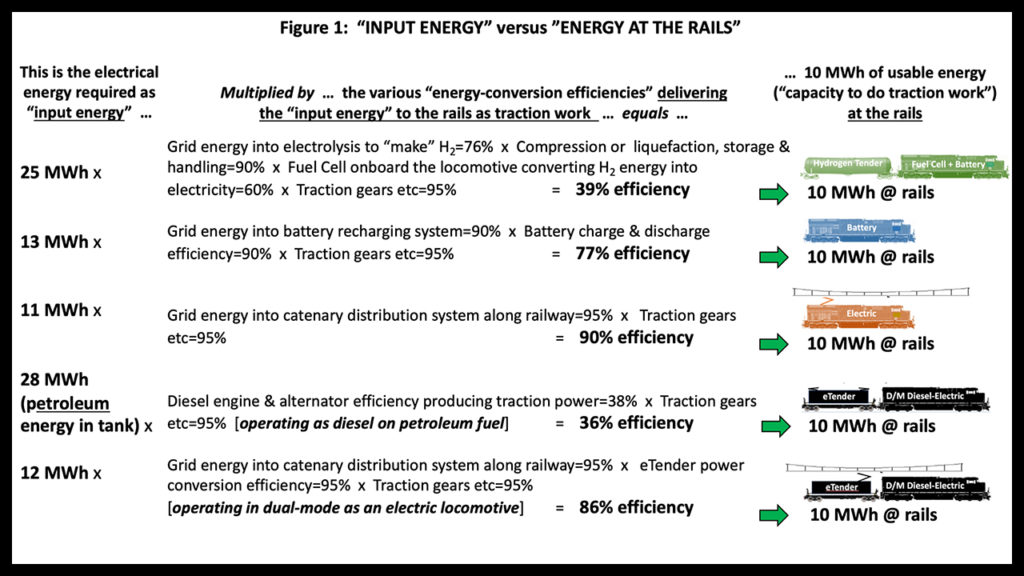
Figure 1 (above) shows the numbers. The calculations and assumptions are mine. I am defining “energy efficiency” as the percentage of grid power (input energy) that reaches the rails as traction work (energy at the rails). I’m using 10 MWh at the rails for mathematical simplicity. (As reference, a 5,000-U.S.-gallon diesel fuel tank contains about 72 MWh of “usable” energy that can be delivered to the rails as traction work. And one MWh is the same as 1,341 hp applied for 1 hour.)
Conventional electric locomotives have the highest apparent grid-to-rails energy efficiency (90%), followed by battery-electric locomotives (77%) and then hydrogen fuel cell locomotives (39%). Electric locomotives on a heavy-density route have the greatest potential for regenerating and reusing dynamic braking energy, further improving their efficiency.
BATTERY LOCOMOTIVES FOR LONG HAUL?
Experimental battery-electric locomotives are advancing through early development stages. I’ve ridden on one, and the technology is impressive. They will be limited by the amount of energy that can be stored onboard and unlikely to match the operating range of modern diesel locomotives (at least with the current battery technologies). Less operating range means more frequent stops to “refuel” (recharge). Yes, dynamic brake energy can be recovered, but it isn’t a universally determinable quantity. It will be dependent on route topography, and railroads often limit the amount of dynamic braking for train handling safety.
That makes hydrogen fuel cell locomotives (with lower grid-to-rails energy efficiency) likely our best option for many—but not all—line-haul U.S. freight operations. As I stated earlier: “As a trained engineer, I believe there will be valid applications for both hydrogen-fuel cell and battery-electric locomotives, but neither is a ‘one size fits all “silver bullet” solution.’”
ET TU, FUEL CELLS?
Why is fuel cell technology for rail seemingly less energy efficient than battery? Fuel cells involve more “energy conversion efficiency losses.” Again, see Figure 1. But hydrogen fuel cells have greater operating range than batteries, so we trade off lower efficiency for longer operating range.
BACK TO THE STRAIGHT ELECTRIC OPTION
We need to electrify only the heaviest density main lines—11,900 route-miles or 19,000 track-miles (assuming 1.6 main tracks per route-mile) handling 30% of U.S. rail freight GTMs at the lowest energy cost. This points to several key corridors: Chicago to Ogden, Barstow, Buffalo and Pittsburgh, plus Vancouver-Calgary. The Powder River Basin would have been a natural candidate but is in decline.
The classic “arguments” against railroad electrification include “excessive” capital investment. However, no hydrogen or battery charging infrastructure has been designed, and none built, for unknown dollars, so what constitutes “excessive”?
Remember the claimed intolerance for electric locomotives geographically tethered to catenary? Hydrogen fuel cell and battery locomotives will also be tethered to their own fledgling infrastructures until both become jointly and universally adopted “everywhere.”
No form of energy will ever be risk-free. Example: Hydrogen prices nearly tripled in the summer of 2022 due to high electricity prices in Texas, combined with other technical challenges.
ELECTRIFICATION CAPEX IN PERSPECTIVE
Assume US$3.5 million per track-mile for freight-speed electrification translates to $66.5 billion for electrifying 19,000 track-miles. This is equivalent to funding only six Belen-size hydrogen production sites, plus a small fleet of fuel cell locomotives and H2 tenders.
Fund it from either future rail earnings, energy savings or from one or more toll-based “pay as you go” funding projects by the feds or a new infrastructure bond program. Why not negotiate a second party building the catenary, selling power to the railroad and transmitting renewable electrical power along the right-of-way?
IN CONTRAST, SOME NUMBERS TO CONSIDER (AND DEBATE)
How much investment is needed for hydrogen infrastructure? The world’s largest renewable hydrogen plant is now being completed in China to produce “only” 20 million kg of hydrogen annually at a capex of about US$500 million (unadjusted for China’s labor and material costs). Scaling that example to a projected annual 300 million kg hydrogen demand at Belen gives us an equivalent capex of roughly US$7.5 billion, and we still need to add capex for large-volume H2 storage and transfer hardware for “refueling” and a fleet of cryogenic liquid or high-pressure compressed H2 fuel tenders, in addition to hydrogen fuel cell locomotives. Round up to US$10 billion for the H2 plant and a “starter fleet” of fuel cell locomotives and H2 tenders. Multiple that by multiple locations/corridors.
Pumping 300 million kg of hydrogen per year is equivalent to hydrogen refueling of 100 Toyota Mirai fuel cell cars every minute. (The only world-class global entity in transferring large volumes of hydrogen is NASA.)
Railroads are unlikely to build massive hydrogen plants, but will ultimately pay for the electrical energy used in making hydrogen, impacting operating costs.
A UNIQUE SEGMENTED APPROACH TO ELECTRIFICATION
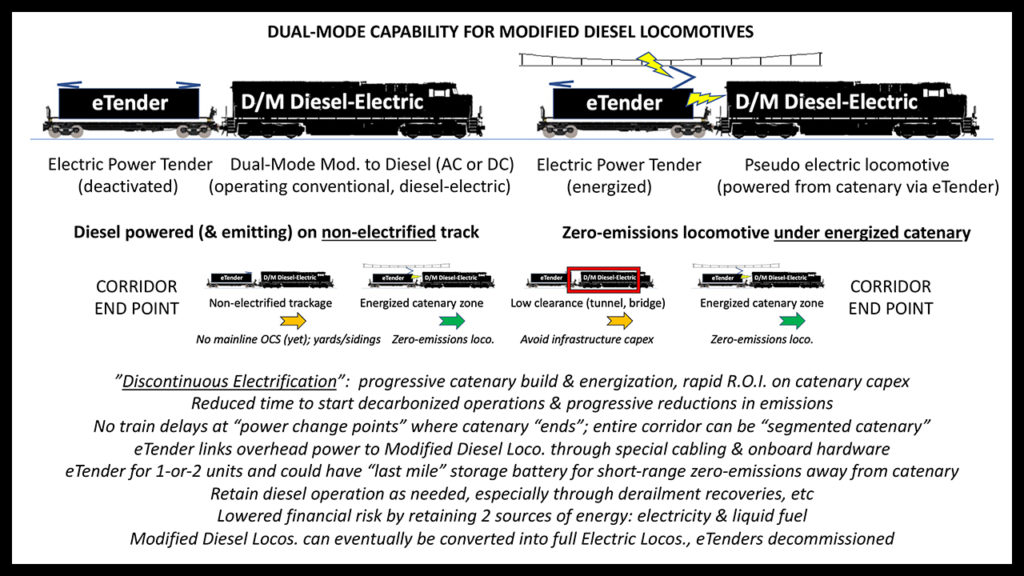
There is a unique alternative to “conventional” electrification, involving a concept I first envisioned many years ago during my Class I career (and others have likely had similar thoughts). My LLC has been developing the concept since 2019, and since 2020 in cooperation with CAD Railway Industries from Montreal: “discontinuous electrification” and diesel-electric locomotives modified to accept “overhead power” through power connections from an “electric power tender” (an “eTender”). See Figure 2 (above).
The “eTender” collects high-voltage power from the energized overhead catenary, conditions and passes it into a modified diesel locomotive, substituting for power from the diesel engine/traction alternator, enabling low- or zero-carbon operation. My LLC and CADRI have been discussing this concept with a major international heavy haul railroad seeking the optimum approach to rail decarbonization.
From an economic perspective, “discontinuous electrification” and “eTender” technology will enable a heavy-density railroad to rapidly start “zero emissions” along a corridor as soon as fractional (even disconnected) segments of catenary are installed and energized (example: Willow Springs-Galesburg, then Barstow-Belen), instead of waiting for the entire corridor to be electrified (Corwith-Los Angeles). The financial risk of a single energy source, be it grid electricity, hydrogen or diesel, is reduced by enabling selective use of two forms of energy. The railroad gains “energy leverage” (unavailable for 63 years) and a faster return on invested capital.
BOTTOM LINE
All propulsion technology options, including infrastructure needs and grid-to-rails energy efficiency, must be thoroughly and professionally evaluated. And railroads need to be active in those discussions. Remember the sage advice of late New York Yankee catcher Yogi Berra: “If you don’t know where you’re going, you’ll end up somewhere else.”
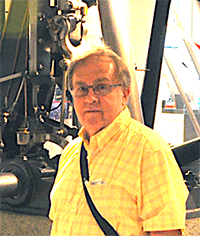
The career of Michael Iden spans 50 years including positions at Southern Railway (management trainee, Engineering & Research), GM-EMD (locomotive and engine manufacturing), C&NW (AVP-Motive Power) and Union Pacific (Senior Director Locomotive Engineering). He is a registered professional engineer in three states and was an FRA-licensed locomotive engineer at C&NW and UP (he never worked as a locomotive engineer but believes those who acquire and maintain locomotives should fully understand their use). After retiring from UP in 2018, Iden began consulting as Tier 5 Locomotive LLC (registered in 2013 “… before emissions Tier 4 became law …”) and serves clients particularly in the railroad and locomotive industries, focusing especially on emissions, decarbonization and managing the introduction of new technologies. He has served as chair of numerous AAR Committees including the first chairmanship of the Coupling Systems & Truck Castings Committee in 2004, is an Advisory Trustee for Southwest Research Institute in San Antonio, Tex., and has been a guest lecturer for Michigan State University. Iden has a BSME from the Milwaukee School of Engineering and a Master of Management degree from Northwestern University, is married with two children and lives in Illinois. The opinions expressed are his own, independent of Railway Age. Always remember Putt’s first law of invention: “An innovated success is as good as a successful innovation.”
See Also:
Rail Fleet Decarbonization Opportunity: What Does it Mean for You?


